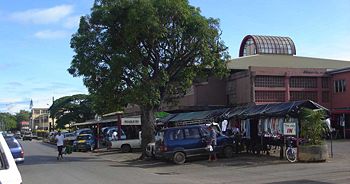Nukuʻalofa


Nukuʻalofa, population 22,400 (1996), is the capital, chief port and largest city of Tonga. The city is located on the coast of Tongatapu island, located at (-21.13333, -175.2).[1]
Nukuʻalofa is the commercial, transport and social centre of Tonga. It comprises about 35% of the kingdom's population. The Tonga Royal Palace is located there.
Contents |
History
Nukuʻalofa proper is only a small area around the hill besides the palace, the Sia ko Veionga (Veiongo hill). It was chosen as his residence by the Tuʻi Kanokupolu Mumui, sometime around 1795. Although the Tuʻi Kanokupolu was the worldly ruler of Tongatapu at that time, the royal court was still located in Muʻa with the Tuʻi Tonga, or the Tongan line of kings. As such, Muʻa was the capital at that time, not Nukuʻalofa.
Tupoumālohi built a fortress there during the beginning of the 19th century.
It was on one of his raids in 1837 that Tāufaʻāhau I invaded the area near Fasi mo e afi with his tautahi (sea warriors), the warriors from Haʻapai and Vavaʻu. As a reward, his men received parcels of land near the old existing settlement, Kolomotuʻa (old-town), which were named collectively Kolofoʻou (new town), the two of which are separated by the Hala Vahaʻa kolo (village separation road).
Nukuʻalofa was not made the capital of Tonga until 1845 by Tāufaʻāhau I (though he still resided in Lifuka from 1847 to 1851). It remained a small village initially, slowly growing in size over time. The area immediately east of it, Fasi mo e afi, was not subdivided and allotted until 1923. Around the time of the Second World War Fasi mo e afi connected to Maʻufanga, the estate of the Fakafānua chiefs, which was positioned further to the east of Fasi mo e afi. It was there that a new wharf was built by the American army in 1942, still known as Fā-ua (meaning: 42). In the west it reached as far as Sopu ʻo Tāufaʻāhau, which was deemed far enough from town for Queen Sālote to be exiled when the whole population of Nukuʻalofa was forced to evacuate due to possible war attacks.
After the 1960's the town started to grow quickly, and it still is growing, in part due to its slow absorption of older villages around it, such as Tofoa.
Much of the business district of the city was destroyed during the 2006 Nuku'alofa riots.
Government
There are district officers (ʻofisa vahe) and town officers (ʻofisa kolo), as there are in all villages, but their main task is only to forward the orders of the government to the people. Services like police, fire brigade, hospital, and so forth are all arranged by the national government. Positions for town officers are usually advertised for in the newspapers.
Transport
Nukuʻalofa is the central hub of all transport.
Buses arrive and depart from the central bus station along Vuna Road (the boulevard) close to the centre of town. Buses are privately operated and their drivers are free to drive whenever they want. There is no regular schedule, and if a driver is not in the mood to go one day, then there is no bus. Fares are fixed by the government, with reduced rates for school children. Usually the buses are filled to capacity. In addition some schools and big hotels have their own buses.
There are numerous taxis, also privately owned. Many people who own a car earn extra money with taxi services in their spare time. Taxi fares too are set by the government.
There are no railways or trams in Tonga.
Most families have their own car nowadays, and the traffic on the roads, especially Friday afternoons and Saturdays is heavy enough to give long queues. Bicycles are few. A lot of walking is still done too.
Nukuʻalofa harbour is the only deep-water harbour of the island (which was the reason that it was selected as the site for the capital). For many years Vuna Wharf was the international harbour, until it was destroyed by the 1977 earthquake. A new, much larger wharf was built towards Maʻufanga, named after Queen Sālote.
The fishermen and inter-island ferries wharf, numbered '42', is between the two. It is the central hub for boats to the outer islands. There are usually two boats to ʻEua every day and two to Haʻapai and Vavaʻu every week. In addition to these regular services by shipping companies, there are less regular services from private boat owners to smaller islands like Nomuka, ʻEueiki, and so on.
Air transport is provided at Fuaʻamotu International Airport on the south side of Tongatapu, 35 kilometres from Nukuʻalofa.
Sister cities
See also
- 2006 Tonga earthquake
- 2006 Tonga riots